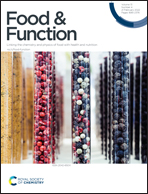Protective effects of chlorogenic acid on the meat quality of oxidatively stressed broilers revealed by integrated metabolomics and antioxidant analysis†
Abstract
Oxidation is a major cause of meat quality deterioration during broiler production, which leads to undesirable meat color and impaired water holding capacity (WHC), thereby impacting consumer appeal and satisfaction. Chlorogenic acid (CGA), a natural phenolic acid, is regarded as a potential, safer and healthier antioxidant to improve meat quality. To investigate the protective effects of CGA on the meat quality of oxidatively stressed broilers, 240 one-day-old male Cobb broiler chickens were allocated to four treatments: basal diet (control group), basal diet + dexamethasone (DEX) injection (DEX group), basal diet containing 500 mg kg−1 CGA (CGA group), and basal diet containing 500 mg kg−1 CGA + DEX injection (DEX_CGA group). Meat quality, antioxidant capacity, the nuclear factor erythroid 2-related factor 2 (Nrf2) pathway, and metabolomic profile were detected in the breast muscle of broilers. Then, correlation analysis between meat quality and antioxidant capacity, antioxidant-related genes, and metabolites was performed. The results indicated that CGA supplementation improved the growth performance and meat quality traits (pH, WHC, and meat color) and enhanced the antioxidant enzyme activity by activating the Nrf2 pathway in the breast muscle of oxidatively stressed broilers. A total of 619 metabolites were identified, among which 93 differential metabolites were found between control and DEX groups, and 65 differential metabolites were observed between DEX and DEX_CGA groups. Breast metabolic profiles were changed by DEX treatment, while CGA supplementation could normalize the metabolic changes in DEX-challenged broilers. Metabolic pathway analysis revealed that most of the differential metabolites between DEX and DEX_CGA groups were involved in pyrimidine/purine, propanoate and phenylalanine metabolism, primary bile acid biosynthesis, and lysine metabolism, which may contribute to explain the protective effects of CGA on meat quality. Moreover, according to the correlation analysis, four metabolites were identified as potential biomarkers to predict the meat quality. In conclusion, our findings demonstrate that CGA is an effective, natural and safe antioxidant to enhance the quality of meat from intensive industrial poultry production.



 Please wait while we load your content...
Please wait while we load your content...